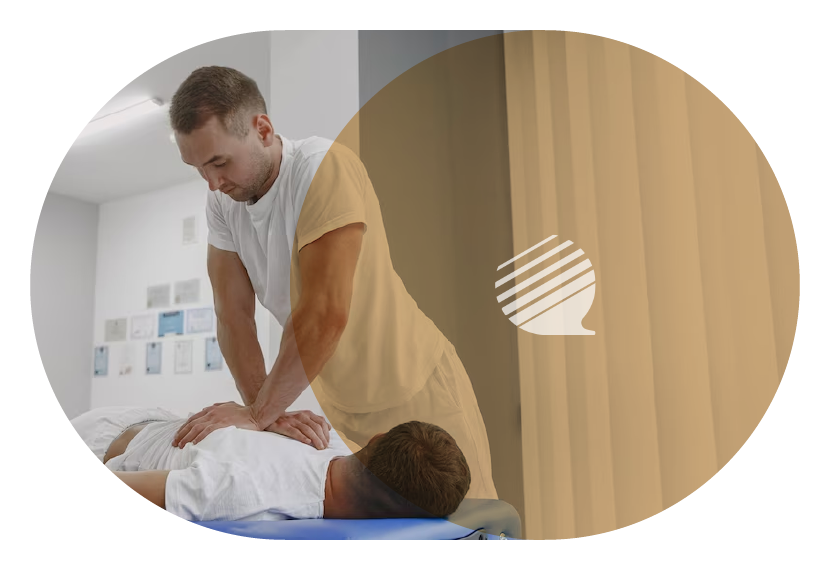When you hear the word “shoulder pads” you probably think about the ones that professional American football players wear. Players are burdened with them because they’re a requirement. They’re huge, heavy, and often they restrict movement. The shoulder pads in your chiropractic career are metaphorical. Someone’s got to be responsible for different aspects and milestones in the delivery of care and the receiving of care and often, doctors think they are the ones responsible for everything. Wielding that responsibility is like wearing shoulder pads.
Shouldering the Burden
Unless you intervene with chiropractic coaching in your clinic’s communication, eventually every staff team member and doctor at the practice will all start wearing the shoulder pads and bearing responsibility for the patient. Everyone in the practice will carry the burden of the patient’s progress on their shoulders. This is typical in practice and a major topic in the chiropractic coaching within the TPMI Clinic Complete program.
But what if you were the first doctor to empower your patient with responsibility for their health and at the same time make them see that they have more control over their health than they would have ever imagined?
A few months ago, there was a massive questionnaire sent out to about ten different practices and presented to more than 1,000 patients. The question posed to the patients was: do you have control over your health?
Just over 90% of the patients replied no, they felt they had no control over their health.
So if a patient is coming to you who believes they do not have any control over their health, who is in control? It would be very easy on your part to take on the shoulder pads of responsibility, direct everything in their care, and potentially even become emotionally attached to the clinical outcome, objectively or even subjectively. In other words, when a patient subjectively improves, you see how they look at you as though you walk on water, and most doctors will gladly take credit for the success. However, on the flip side of the coin, if the patient doesn’t improve, many doctors feel responsible for what they see as a failure. When that patient looks at you, they may be thinking that you don’t know what you’re doing. And when that happens, you move from one end of the spectrum to the other.
If you do that, once a day, two times, three times a day, five days a week, you can really crash and burn. That’s why as doctors we must think about who owns the pain or complaint. When a patient comes into your clinic with pain (in their neck, back, etc.) or a complaint (vertigo, breathing, etc.) who owns them? The patient, of course. You couldn’t own that pain or complaint for any amount of money. Could you take the pain out of their head for $5,000? $10,000? You can treat them and guide them to wellness, but you do not own their pain. You are not in complete control.
Another thing doctors in my chiropractic coaching program hear is that they also cannot be responsible for the negative life impact on the patient because of their pain or complaint. TPMI chiropractic coaching has categorized life impact into these areas:
- Work
- Relationships
- Recreational activities and/or hobbies
- Work around the house
- Sleep

Again, with TPMI chiropractic coaching, doctors learn how to take off the shoulder pads and realize that the patient owns their life activities too. Doctors should offer patients two options: patch care or fix to as near normal as possible care. If a patient only chooses patch care and nothing more, they’ll quit in the first nine visits. And as you have heard, the average chiropractor will see six out of 10 new patients quit in the first nine visits. What is the difference between a patient that quits your clinic and one that stays? Commitment.
Commitment in Care
In a report of findings, most people will choose a type of care. They do not commit to care in the report of findings. They commit after their ninth visit. If you see them beyond nine visits, they’re committed. Only your care and your ability to connect with them about their care will encourage their commitment. And if you teach them how to take responsibility for their care, we’ll see the majority of patients move from choice to commitment.
Statistically speaking, if a patient stays beyond nine visits, it’s because they are committed, and they will probably be there for more than 20 visits. Very few people seem to be quitting between their tenth and twentieth visit. Long-term patients stay because they own the commitment to their care. They have taken the shoulder pads from you and are now wearing them.
And if the patient responds subjectively and objectively under care, who owns the fact that there is no pain? Who owns the fact that there is no problem in the spine? Who owns the fact that the negative life impact is now positive? Or even the choice to choose care? It’s all the patient! And if they eventually realize the control they have, they will probably think to themselves, gosh, this was a really good choice.
Finally, insurance is also a factor for many patients. If there is no insurance or if it runs out at some point, who owns the responsibility of paying cash for their care? Maybe you have found yourself paying for patients to come in to see you. Who do you think owns the fact that treatment was an investment, yet it was money well spent? The patient owns it all, and couldn’t sell it to you, give it to you, or force it upon you.
Are you communicating responsibly?
One of the most important aspects of TPMI’s chiropractic coaching is communication, and how your communication makes the difference in how patients take responsibility for their care. Are you giving them the opportunity to wear the shoulder pads? Up until now, the shoulder pads have probably been spinning toward you and your team and landing on your shoulders.
When was the last time you said to a patient…
“I have figured out what’s going on here. And now I know I can fix this; I’ve seen hundreds of cases like this, and most patients are far better off or completely healed when I’m done.”
Do you hear how you take responsibility away from the patient? You are telling them what you can do. You might even go on and tell the patient that they need to get this problem fixed to as near normal as possible, commit to care and pay for that care. TPMI chiropractic coaching teaches a different way to communicate. If you’ve spoken like that to patients, you have taken the shoulder pads of responsibility and ownership from them and put them on your shoulders, which automatically puts them on your staff team’s shoulders as well. And those shoulder pads get heavy because you have made yourself responsible for every patient every day, every week.
A little chiropractic coaching can show you that the difference between communicating with the shoulder pads on and letting the patient wear them is embedded in the little words you use every day in our conversation with patients—pronouns. Choosing the right pronouns when you speak to your patients greatly encourages patient ownership and responsibility. TPMI’s chiropractic coaching program uses a pronoun chart, featuring “forward pronouns” which are instrumental in helping doctors learn to communicate for a commitment from their patients.
Here’s how.
 TPMI chiropractic coaching demonstrates that in speaking with doctors, staff teams, and educating patients, there are only three pronouns you should use: you, your, and yours. These pronouns assign ownership and responsibility to the patient. Other pronouns used in chiropractic coaching are called reverse pronouns. There’s a much longer list of those, such as me, we, our, us, and ours. Strategic chiropractic coaching can help doctors and staff team members eliminate those pronouns from patient conversations and keep the shoulder pads on the doctor instead of the patients.
TPMI chiropractic coaching demonstrates that in speaking with doctors, staff teams, and educating patients, there are only three pronouns you should use: you, your, and yours. These pronouns assign ownership and responsibility to the patient. Other pronouns used in chiropractic coaching are called reverse pronouns. There’s a much longer list of those, such as me, we, our, us, and ours. Strategic chiropractic coaching can help doctors and staff team members eliminate those pronouns from patient conversations and keep the shoulder pads on the doctor instead of the patients.
Another area to be aware of in your speech are the reflexive pronouns (ourselves, myself, yourself, etc.). There are many, many, many reflexive pronouns to avoid in place of the forward pronouns. With some chiropractic coaching, forward pronouns will take center stage in your conversation with patients as well as the communication from your front desk team.
Consider the differences in the following two responses from a front desk person to a patient who is late for their appointment. One has had some chiropractic coaching and one has not. Imagine them on the phone and what the patient will hear from them.
RESPONSE #1:
“Hi Mr. Smith, I had you scheduled for an appointment in our clinic at 10 o’clock this morning, and we are wondering what’s going on. We are here until six this evening to reschedule. Please call us.”
RESPONSE #2:
“Hi, Mr. Smith, you had an appointment at 10 o’clock and are now ten minutes late. This call is to remind you that you need to get in for the care you chose as soon as possible. The clinic is open until six this evening. Please call back as quickly as you can in order to reschedule your appointment today.”
The first response could use a little chiropractic coaching. Did you see any forward pronoun, such as you or yours? Instead, it is all about the front desk and the clinic. It is about our policy, our clinic, etc. In the second example, we use lots of forward pronouns and remind the patient they are not showing up for something they want.
Your patients aren’t going to just assume ownership and responsibility for their care simply because of the usage of forward pronouns; additional chiropractic coaching is necessary, but you must use them as you teach. After a while, you will see that most patients will begin to take on responsibility for their care.
Doctor, do think very seriously about these pronouns. In chiropractic coaching, doctors speak of how aware they are of their forward and reverse pronouns. When they hear an “I” or a “me” come out of their mouth, they immediately realize they are taking on ownership, or claiming to be in control. Paying attention to your pronouns not only will help you communicate more clearly but will also help you eliminate reverse pronouns. With a little chiropractic coaching, you will be able to hear them come out of your mouth. Paying attention to your speech and a little chiropractic coaching can go a long way in building patient responsibility.
The whole concept of patient responsibility is a big issue within chiropractic coaching, and a functional philosophical topic to be taken seriously. The best way to see the majority of your patients take on ownership and responsibility is if you can use forward pronouns as you teach them so you can put the shoulder pads where they need to be—on the patient’s shoulders—instead of on yours with the word “stress” carved into them with a blunt screwdriver. On the patient, the shoulder pads are smaller, lighter, and they have their name on them in indelible ink. Best of all, with a little chiropractic coaching, the patients are happy to wear their own shoulder pads if you help them understand how and why to do so!
TPMI chiropractic coaching programs can help you teach patients to take responsibility and ownership of their care.
Contact us at 608-463-7474 to learn more.




